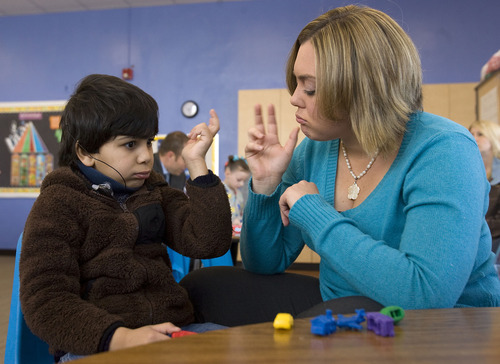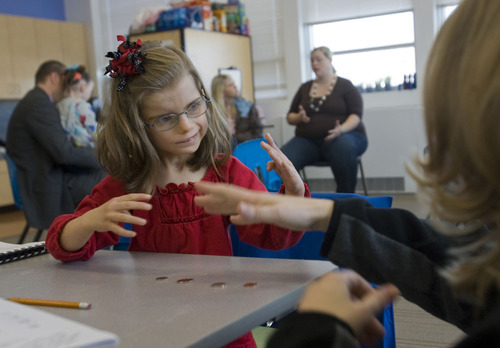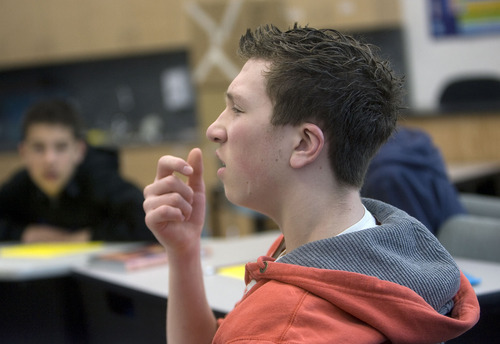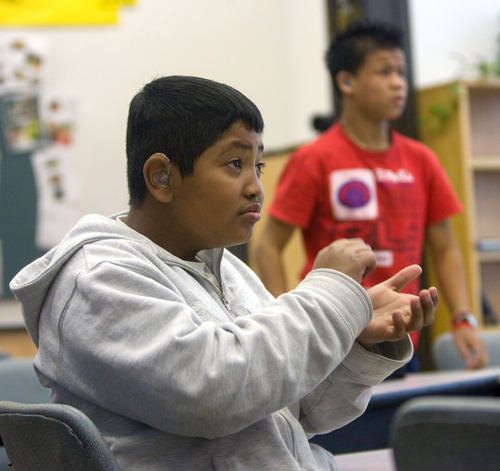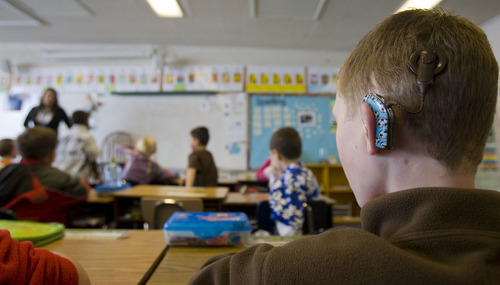This is an archived article that was published on sltrib.com in 2011, and information in the article may be outdated. It is provided only for personal research purposes and may not be reprinted.
Millcreek • At Jean Massieu School of the Deaf, 5-year-old Athziri plays a card-matching game in her preschool class. She is learning to recognize animals and name them in American Sign Language, forming her hands to say "zebra," "bear" and "monkey."
A few miles away, Ryan, 3, is in his first year of preschool at Upland Terrace Elementary. Ryan, who is deaf, is learning to listen and speak aloud with the help of a cochlear implant behind each ear.
"We're going to go outside and play," he says clearly.
Both children are students of the Utah Schools for the Deaf and the Blind. But their parents have chosen different routes for their education. Superintendent Steven Noyce hopes the two-track program — American Sign Language/English or listening-and-spoken language — will empower parents and become a model nationally for other state schools for the deaf, which predominantly teach students ASL with English taught as a second language.
But many advocates for bilingual deaf education fear that Noyce, whose experience as an educator is in listening-and-spoken language (LSL), favors the oral program at the expense of a traditional deaf education in American Sign Language. ASL — more readily accessible to visual learners — unites the deaf community and fosters a deaf identity, advocates say.
"Noyce doesn't understand the deaf signing segment of the student population well enough to advocate adequately for them," declared eight deaf-education advocates, including Bronwyn O'Hara and Jodi Kinner, in a recent opinion piece in The Salt Lake Tribune. "The Utah Schools for the Deaf and Blind (USDB) are in a state of crisis."
Noyce, who became superintendent 18 months ago, is accustomed to the criticism, which began before he even started the job. Many of the critics want Noyce, who was appointed by the Utah State Board of Education, to be replaced. Nearly a year ago, concerned parents launched the Utah Deaf Education Core Group (http://www.utahdeafeducation.com) and demanded a review of Noyce's performance.
"I don't have any problem with people being an advocate for American Sign Language," Noyce said in an interview. "I wish those who advocate for ASL wouldn't have a problem with those who advocate for listening-and-spoken language. My role is to support very strongly both programs equally."
Over the past decade, listening-and-spoken language education has become an increasingly popular choice due to the growth of cochlear implants and digital hearing aids to recover or amplify hearing. Since before Noyce became superintendent, the rate of parents choosing listening-and-spoken language at USDB has been 70 percent or higher, he said.
In the United States, roughly 41,500 adults and 25,500 children have cochlear implants, according to a 2009 report by the U.S. Food and Drug Administration. Among children, earlier implantation — allowed at 12 months — means they can be exposed to sound during the time their brains are developing language and speech skills. They need intensive therapy to learn to interpret the signals the electronic devices send to the brain.
"Cochlear implants changed everything," Noyce said. "Kids can identify sounds 20 feet away. Some of these kids can hear whispers. I think it's miraculous what technology has done."
—
Making the choice • Noyce's most noticeable changes at the Utah Schools for the Deaf are in the parent-infant program, which serves children from birth to 3 years and their parents. Because that is a critical period for language development, Noyce now encourages parents to make a choice of ASL/English or LSL as early as possible instead of when choosing a preschool.
He has created a new orientation program for parents, which includes a tandem visit from a deaf adult who uses ASL (and an interpreter) and a deaf adult who speaks. Parents meet families in both tracks and attend community events.
Noyce also restructured the staff of a dozen or so early intervention teachers so that all are trained as specialists in either signing or speaking programs. Previously, only one had a background in LSL. Now there are twice as many LSL specialists as ASL ones to reflect parental demand.
Seventy-four percent of parents currently in the program have chosen LSL. Fifteen percent have chosen ASL, and the remainder are undecided. There are 170 infants and toddlers enrolled.
"I want Gavin to not just be able to communicate with deaf people but hearing people. We live in a hearing world," said Heather Frost, whose 4-year-old son is attending the LSL preschool at Upland Terrace Elementary. "He hears at normal levels with his cochlear implants. It's almost like he doesn't have this disability."
That means Gavin can enjoy music and movies — popular family activities. And with the LSL program focused on returning students to general education classrooms by third grade, Gavin is on track to be attending his Draper neighborhood school in first grade.
But advocates for the ASL program would prefer infants and toddlers be given more time to test their skills at both signing and speaking so parents can make a choice that reflects the child's aptitude as a visual or auditory learner.
"My question is: How do parents know which language the child needs?" asked Jill Radford, director of the Jean Massieu School, who is deaf, in an e-mail. "I promote choice, but I believe strongly that it needs to be the child's choice. Often parents will pick what is most convenient for them and their family [LSL] because the child needs to be able to communicate with them."
Jake Dietz, a hearing parent of a 2- and a 4-year-old with hearing loss, said the emphasis on choosing early leaves few options for parents who want their infants and toddlers to become well-versed in both ASL and speech. He has chosen ASL for both his children.
Before dividing the parent-infant program into two tracks, parents could choose services a la carte, Dietz said, seeking the help of both speech therapists and deaf mentors (educators who teach family members how to sign).
"What they have right now at USDB is you either choose cookie-cutter one or cookie-cutter two," Dietz said. "It's not individualized at all."
Noyce said ASL teachers in the infant program — like those in preschool and K-12 — are trained to teach "oracy," along with sign language and English literacy. Oracy includes listening, speaking and reading lips.
Noyce also dismissed claims that spending favors the listening-and-spoken language students. Although there are more LSL students, their education is less expensive per child. From infancy to graduation, on average, it costs $288,000 to provide an ASL/English education and $121,000 to provide an LSL program, he said.
Much of that is due to the focus of LSL on returning students to mainstream classrooms as soon as their listening and speaking skills are at grade level. Plus, USDB relies on free classroom space in existing public schools to teach LSL students.
"Superintendent Noyce has a very challenging position. He has to try and balance many different needs," said Jennifer Howell, who resigned as USDB associate superintendent last month to take another job. "I have seen him try to support the ASL programs in decisions that he makes. I'm not sure that his support is always perceived by everyone who is looking at the school." —
About the Utah Schools for the Deaf and the Blind
Annual budget • $29 million (mostly state funds)
Enrollment • 1,929
Students who are deaf or hard of hearing • 1,164
Options for deaf students • American Sign Language, with English as a second language and lessons in deaf culture and history; listening-and-spoken language, with the goal of mainstreaming students by third grade
Portion of parents who choose listening-and-spoken language • More than 70 percent


